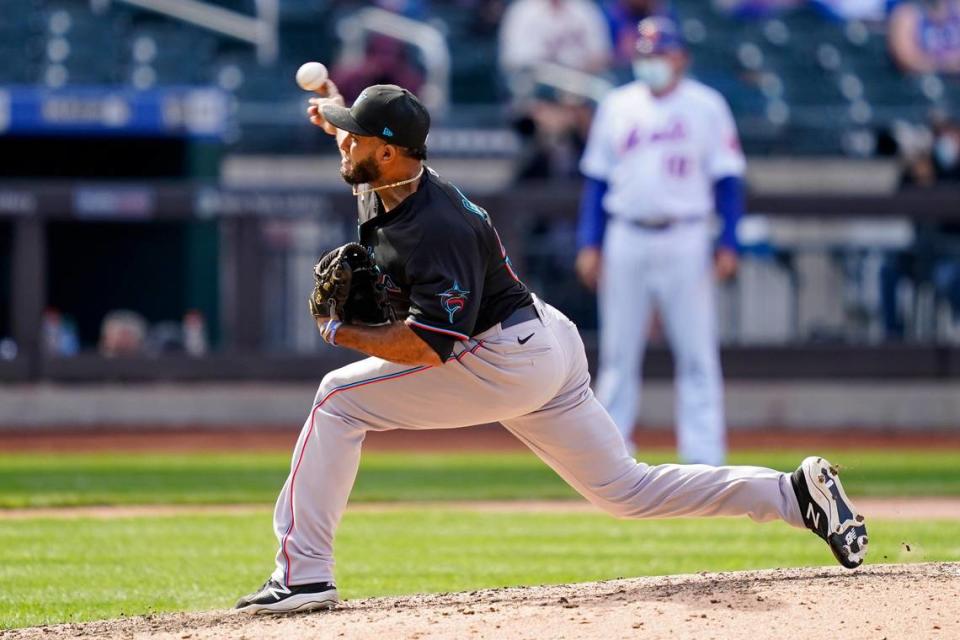Yimi Garcia making his case to be Marlins’ closer. The title, however, isn’t his focus
The situation was not lost on Yimi Garcia.
Bottom of the ninth inning. Tie score. Two on. Two outs. One of baseball’s hottest hitters in Ronald Acuna Jr. at the plate.
Garcia’s mentality was going to be the same. His job was the same, too, even if the pressure was ticked up a little more than usual.
“It’s part of my game,” Garcia said. “Attacking hitters.”
Garcia certainly attacked, throwing four-seam fastballs on six of his seven pitches — topping out at 98.5 mph — although Acuna ended up walking to load the bases.
The attack remained the same in a do-or-die at-bat against Ozzie Albies. Seven four-seam fastballs, none slower than 95.6 mph.
Garcia won this battle, getting Albies to ground out to Garrett Cooper at first base to send the first of four games between the Marlins and Braves at Truist Park to extra innings on Monday night.
Garcia got run support in the 10th, with Cooper and Brian Anderson driving in runs on consecutive at-bats, and then needed 11 pitches to retire Freddie Freeman, Marcell Ozuna and Dansby Swanson to clinch the Marlins’ 5-3 win.
He remained stoic while giving catcher Chad Wallach a fist bump after the final out but flashed a quick smile as the infield came in to greet him.
“He just went after the strike zone,” Marlins manager Don Mattingly said. “He was throwing strikes and getting ahead and attacking all night. That’s what you love out of Yimi. His stuff is so good.”
It’s the latest statement and latest attempt for Garcia to cement himself as the Marlins’ closer after Anthony Bass’ early struggles, although Mattingly has said multiple relievers could get opportunities to pick up saves (Richard Bleier and Dylan Floro also among the options).
But Garcia, a 30-year-old from the Dominican Republic in his seventh MLB season, has also made this clear times during the past two months: He doesn’t care when he enters the game. It could be as the closer. It could be as the set-up man or any other high-leverage situation. Frankly, it could be in the fourth or fifth inning of a blowout.
He doesn’t care.
He’s going to execute exactly the same way regardless of the situation.
“The most important thing for me,” Garcia said, “is to just do my job. Whatever the team needs me to do. If I have to come in during the fifth, sixth, whatever the manager really needs me to do, I’m here to do that.”
And he has done his job.

Since giving up a home run on Opening Day, Garcia has thrown 5 1/3 scoreless innings. He has allowed just four baserunners (one hit, three walks) while striking out four in that span. There’s an uptick in his velocity early, with his fastball averaging 95.8 mph (compared to 94.4 in 2020) and his slider is averaging 88.9 mph (compared to 87.8 mph last season), while his command remains steady.
But there is also something to be said about the trust Mattingly has placed in Garcia since the Marlins signed him ahead of the 2020 season.
The history between the reliever and manager go back to Mattingly’s final two seasons with the Los Angeles Dodgers. Garcia made his MLB debut in the final month of the 2014 season. He had eight relief appearances. He gave up six hits and two runs — both solo home runs — while striking out nine over 10 innings.
In 2015, Garcia’s first full season in the big leagues and Mattingly’s final with the Dodgers, he made 59 appearances and primarily pitched after the sixth inning. He held opponents to a .209 batting average and less than one walk or hit per inning. He had nearly seven strikeouts for every walk.
Mattingly said it’s tough to predict how a young relief pitcher’s game will evolve over time, but he saw potential in Garcia during those early days.
“He was a closer in the minor leagues,” Mattingly said. “When he came up, he was a different guy at that point, a younger guy and he really pitched more down [in the strike zone] than up. He always had that good fastball. His slider has developed over the years. I think the biggest difference now is even though he’s always been able to locate, the fastball up is such a weapon for him because he can get them to the spots he needs to. Sometimes it’s in. Sometimes it’s away. It’s just tough to handle.”
That trust endured when the two reunited in Miami in 2020. Garcia became the Marlins’ main set-up man, primarily pitching the eighth inning to pave the way for Brandon Kintzler’s save opportunities. Of Garcia’s 14 relief appearances pitched last season — he missed time early after testing positive for COVID-19 — seven came in the eighth inning and three others came in the ninth. He gave up one run in 15 innings in that role (a 0.60 ERA). He struck out 19 of 60 batters he faced and held opponents to a .164 batting average.
Mattingly said during the offseason that he would have “total confidence” in Garcia as a closer if the situation presented itself.
“That definitely helps a lot,” Garcia said. “Once you get to a place where you feel that trust, it’s something you keep inside of you. It’s a comfort.”
The opportunity has now presented itself.
He’s 2 for 2 in that situation so far, finishing the Marlins’ 3-0 shutout over the Mets on Saturday for his first save of the season and recording the final four outs on Monday against the Braves to pick up the win.
“Things are working out for me,” Garcia said. “I feel really good.”

